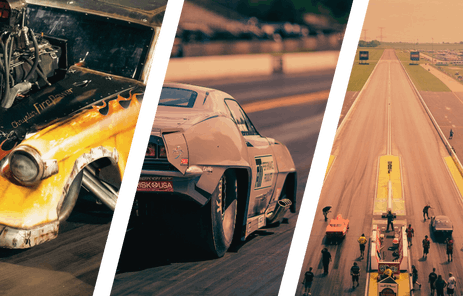We’re coming down to the wire this week with the fourth of five exclusive installments on the build of Brian and Tyler Hard’s 1968 V4 Pro Nitrous Camaro that’s being constructed at Tim McAmis Race Cars in Hawk Point, Missouri. In the first three installments of the build (Part One, Part Two, Part Three), we discussed what goes into building one of these state-of-the-art machines, from the initial 25.1E chassis construction to the engine fitment and seating position to our last installment, which covered the fitment of the body and accessory-mounting process.
This fourth installment, which we’ve been eagerly awaiting since it shows the car starting to come together before the final build process, will cover the interior assembly and powder-coating processes along with a number of other items. So without further ado, let’s get started!
Since we showed off how the body mounting process was handled in the last installment, the team now has a chance to finish up building some of the final parts and pieces. According to master car builder Tim McAmis, “Now that the body is mounted it is time to finalize some of the small accessory tabs and components that go inside of the car that just can’t be located until the body is solidly mounted on the chassis. This is also when we pre-fit all of the carbon fiber interior panels. “
Tyler Hard had made the trip to McAmis previously to be fitted for his Top Sportsman car, so the team had his measurements, and all of the critical positions had been established to this point. Placement of the accelerator and brake pedals, shifter, parachute handles and fire bottle are critical for access from the driver’s seating position.

As you’ll remember from the previous installments of the article, this particular build (as with many that TMRC takes on) has a “weight-critical” mission, as Pro Nitrous cars need to adhere to a strict goal to cross the scales at weight in order to be competitive. Titanium has been used liberally throughout the car in acceptable positions in order to achieve this goal.
Safety is such a critical part of every car build that TMRC takes on, and it’s at this point of the car’s construction that brake and fire bottle lines are fitted. Their installation is a long and tedious process, but when complete the extra steps the team takes during their installation is evident in the final build.

Keeping the driver safe in the event of an on-track mishap is critical, and it’s to this end that the fire system is pointed at the driver to protect him.

In the event of an issue on the track, NHRA rules require that the electrical power turns off automatically in the event of fire bottle activation.
At this point the final accessories have been installed, and it’s time to get the rest of the interior fitted to the car.
Fitment of the wheel tubs to house the monster 36 x 17 meats is the next step of the process – as the body needs to be fitted to the car before these can be installed, the TMRC team had to wait until this step to finish them up.

Once the tubs are installed into the car, the interior fabrication steps are complete, so the body comes back off the car and is set aside at this point.
Of course, now that most of the car is constructed, it’s not so easy to maneuver around anymore due to its weight and dimensions, and this is where the fabrication abilities of the TMRC team come into play yet again. According to McAmis, “We built a fixture so we can rotate the chassis for final welding after it comes off of the table. This is also the time when we fit the steel portion of the floors.”
We talked about weight savings before, but there are specific places throughout the car where specific parts and panels need to be constructed of particular dimensions for driver safety.
The powdercoating process also has the TMRC stamp – Tim came up with the special lightweight process and unique color that is used on all TMRC chassis.
Powdercoating looks great, but also presents a ‘pain-in-the-butt’ factor on the backside of the process, as the powder fills all of the threaded holes that are present on the chassis.
At this point, now that things are coming back together, it’s time for the team to double-check the door and front-end fitment, along with fine-tuning the door and window gaps. After this process is complete, the car is off to paint, and we’ll be back with that installment of the build soon!
As an interesting aside, we got the following two images and information from Tim directly.
You might also like
"Get Busy Living": Health Scare Ignites Group's Drag and Drive Adventures
A father-and-son drag-and-drive story was born from a life-changing health scare. Its built on friendship and much more.



